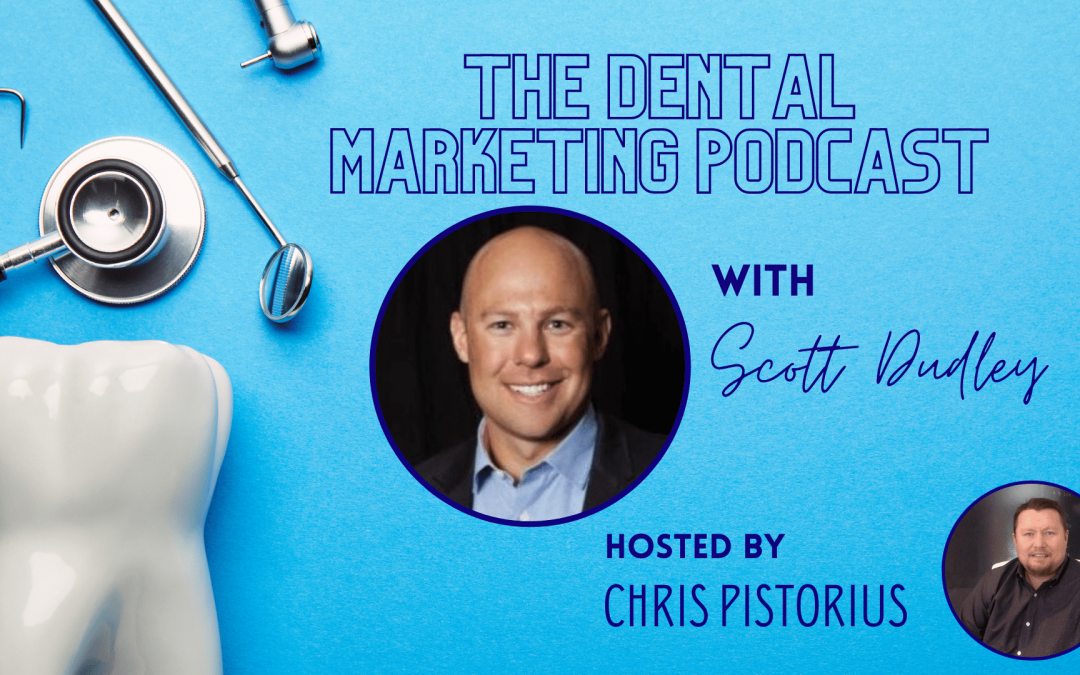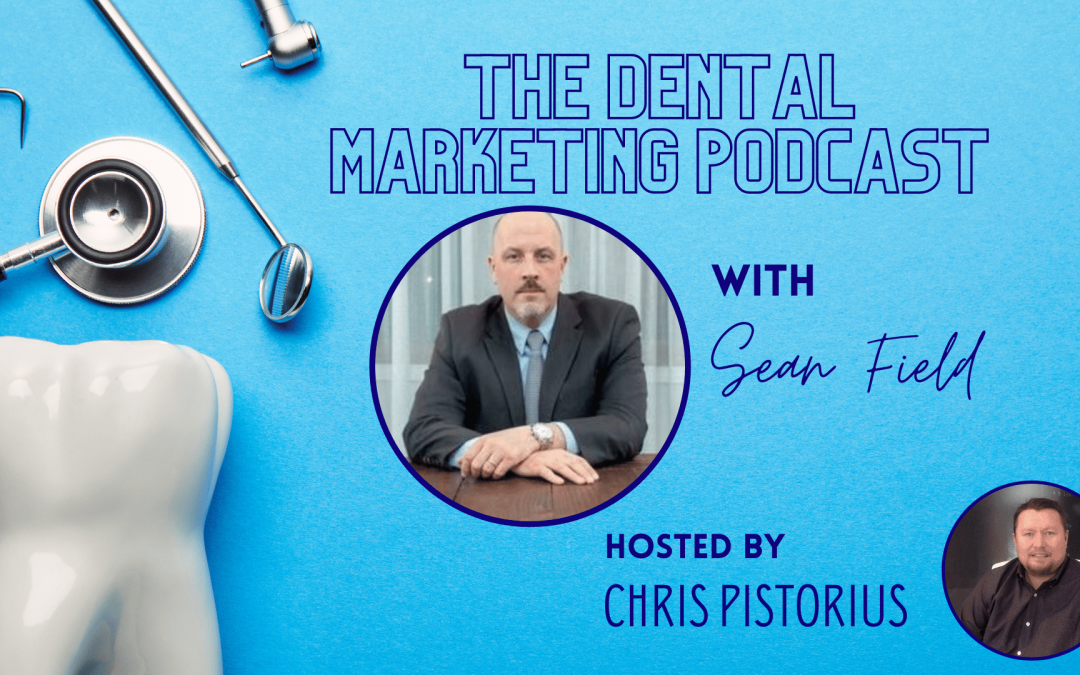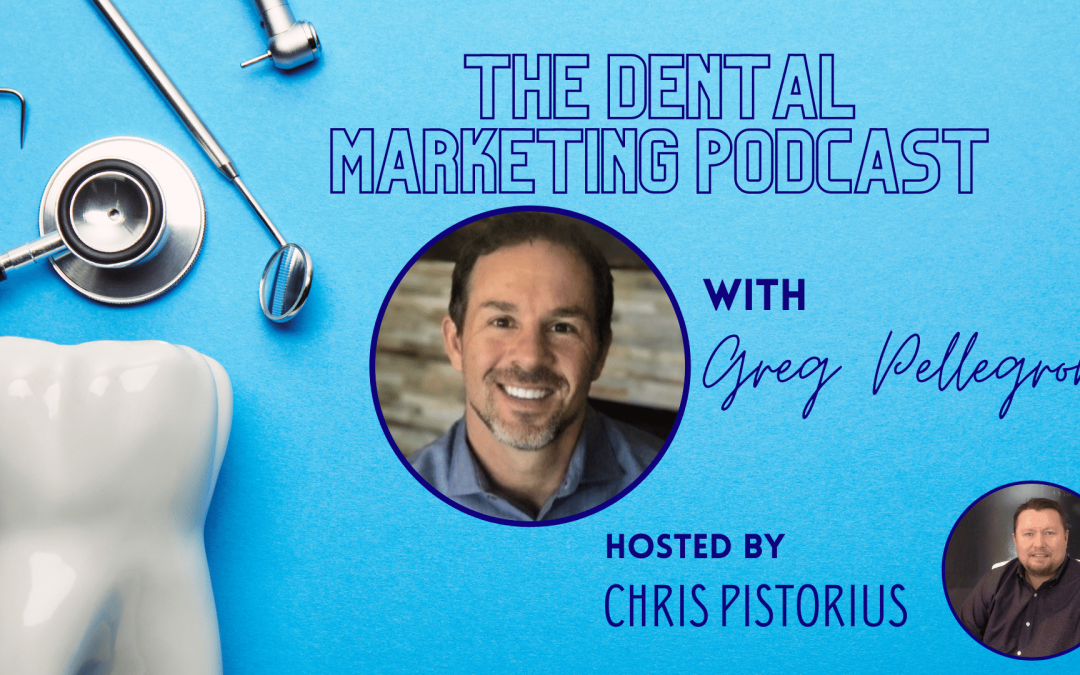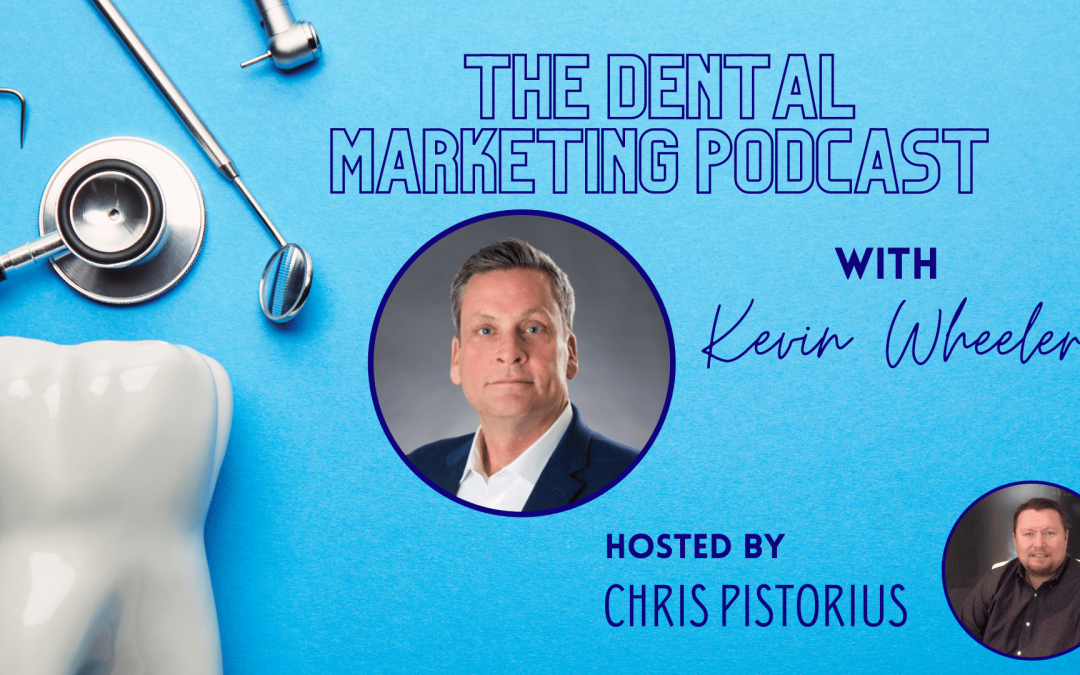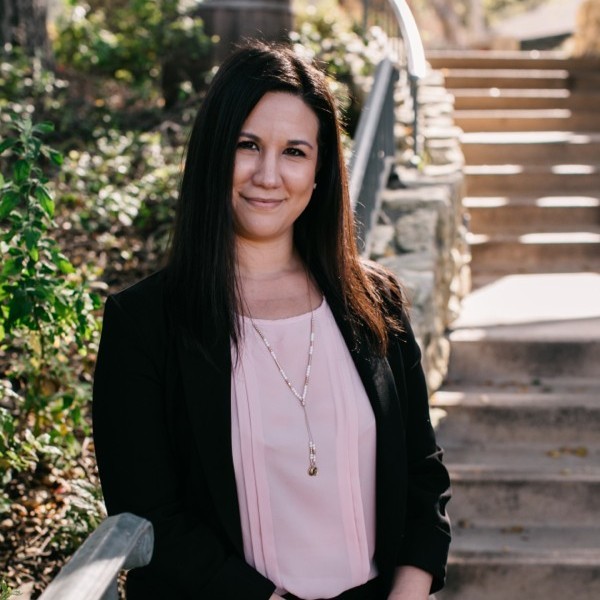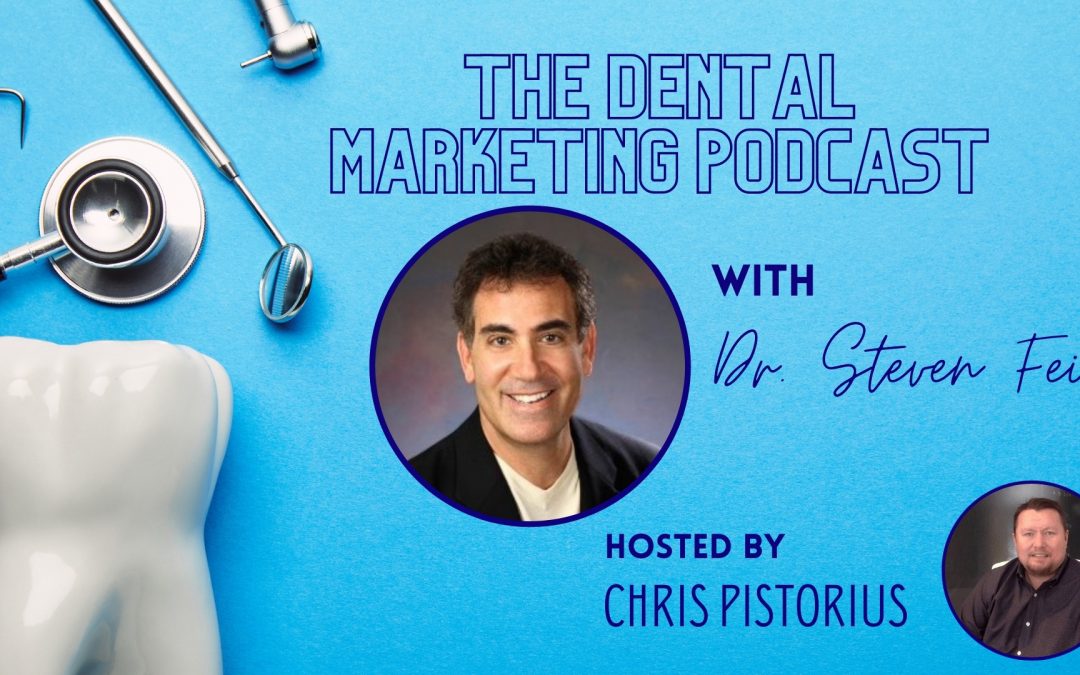
How To Pick The Right Patients For Your Dental Office
Listen to the audio-only version:
Watch the podcast here:
Chris talks with Steven Feit, a practicing dentist for the past 30 years, on how to pick the right patients for your practice.
View Full Transcript
Chris Pistorius (00:04):
Hi everybody. This is Chris Pistorius again with the Dental Marketing podcast. I’m with a great guest today, he’s got tons of experience in dentistry and does a lot of cool stuff. And today Steven Feit, Dr. Steven Feit, is with us today. And we’re going to really get into his 30 plus years of experience and how he’s transformed his practice from very early on in his career to more recently. So Dr. Feit, thanks so much for being a part of the show today.
Steven Feit (00:34):
Thanks for having me on Chris. Really appreciate it. Big fan, happy to chat with you.
Chris Pistorius (00:40):
Awesome. Well, let’s get right to it. I mean, we talked a little bit off air about a little bit of your background and whatnot, and I was kind of floored by how you transitioned over the years and let’s get right into that. What do you do? How do you do it and how have things changed for you over the years in dentistry?
Steven Feit (00:57):
Well, Chris, as we talked, I came out of my residency at the Goldman school up in Boston, I was an associate in New Jersey and as is typical was a bit abused, where they were taking monies and so forth, that most people have had that experience. So I packed up, went to Florida to set up my own practice, and started from scratch. That was 1991. And you know, of course the mode was just take anybody. And we became very, very busy, but we became busy treating a lot of people that were not nice, not reasonable, not respectful, didn’t refer, didn’t repeat, didn’t pay. And I got to the point where I was actually miserable being so-called successful, depending on your definition.
Steven Feit (01:41):
And I latched on with Patty Lund, who was a dentist down in Australia, and I adopted a lot of his front desk lists. We call them care nurses, even though they’re assistants, but they’re not nurses in a medical sense. But our care nurse greets the patient when they come in the office, escorts them to the treatment room, helps me render the treatment, let’s say we’re doing a crown or whatever. And then they know the next step. They don’t have to bring the patient to the front desk. And everyone in the waiting room overhears what’s the conversation. The patient pays in the room. If there’s a discrepancy, which usually never happens, because everything’s done in writing. It’s all in private, no one overhears it and everything is sorted out. And then they’re rescheduled for the next visit and they leave. They can go to the restroom or just leave. It makes a very tight relationship with the care nurse because then when they return that same care nurse is going to be with them to insert the crown with me.
Steven Feit (02:43):
And then that same care nurse will be with them if they need another procedure down the road. So then they get to know each other quite well. And it’s very simple and easy and natural for the care nurse to say, “Listen, we don’t ask everyone, we ask our special patients and you’re one of them. We really enjoy having you and your company. We would love it. If you would refer some friends, because we believe birds of a feather and that kind of thing.” And if the patient says, yes, we find it’s almost like a verbal contract, and they do, they will refer and it works very nicely. So it creates a higher level of care, a higher level of meaning for the day for the care nurse, a higher level of fulfillment. Most people leave a position, not because of money because they feel under appreciated.
Steven Feit (03:36):
And when you’re appreciated by the very person you’re serving, and then I show my people tons of love. Like I put them on such a pedestal. Throughout the procedure if I asked for an instrument, you’ll hear me say, thank you, please, please, can I have this? And I say, thank you. And what happens is the patient is overhearing that whole dialogue. And the patient sees the respect that I’m giving to my person, who is a very special person in my life, that’s why they’re there. And what happens is they in turn at the end, they’ll turn to the care nurse and say, thank you, thank you. And I’ll say, wow, that came out great. It shortened the treatment time. All because of Sarah. Sarah did an awesome job today.
Steven Feit (04:24):
And so most doctors, they feel like to elevate themselves, maybe they have to push other people down. It’s the exact opposite, because guess who hired them? Guess who picked them? It’s a reflection of me. They say, the fish stinks from the head down. Right? Well maybe it smells good from the head down also. So it’s really a nice way to envelop yourself with people all day, all day long.
Chris Pistorius (04:52):
Yeah. That’s an interesting concept. Kind of the no front desk thing. I’m probably making it too simplistic, but when the phone rings and stuff, you still have these care nurses are the ones that answer phones or how does that work?
Steven Feit (05:05):
Yeah, that’s a great point I forgot about. So our patients, being in south Florida we’re in the demographics of, they’re like as eighties, nineties, hundreds. And so their medical issues is of concern and you always want… I have phones, telephones, in every single room. I have computers in every single room, like most offices today of course do. We’re totally chartless, we’re without paper charts. And so they can take a step and answer the phone.
Steven Feit (05:38):
So I have two care nurses. So when I’m with one treating someone, genuinely, the other one is available and can grab the phone, and there’s a computer right next to every phone, and there’s the front desk. In the old days, I practice, can we had a paper schedule, we’d have to move the in a treatment room and get the schedule done and all that. It was a little more complex, but today it’s really quite easy. And with COVID, by the way, everything’s done in the room, it’s for their safety, it actually is a perfect mode of operating, you know?
Chris Pistorius (06:14):
Yeah. I was going to bring that up. That’s that’s a pretty good concept for times like we’re going through right now. Talk to me though, early on you said you took on just about anybody that would pay you, and it was great money-wise, you’re very successful. But something clicked and you just, at the end of the day, you just weren’t happy. How do you transition out of that? How many patients… If you already brought this up, I apologize. But how many patients did you kind of let go to get to your happy spot, if you will?
Steven Feit (06:42):
Yeah. So what we realized is we were actually miserable and we were busy. As Michael Gerber says in the E-Myth, “You’re doing it, doing it, doing it,” and you’re on a treadmill or the hamster wheel, and you’re like, when is this ever going to end? And so, I got to the point where like, I restore old cars. I’m like, I’d rather go to Jiffy Lube and change oil than come here. You know, that’s a pretty dark place. So, one of my friends said, well, if someone’s not going to come back to the office, why does it have to be me? Why not the patient? And whoever gives thought to let go of a patient, because we’re so used to, and inculcated in our training, like you need more patients, get new patients, need more and more.
Steven Feit (07:24):
So what ended up happening was Patty Lund, we copied one of his systems and we rated the patients as A, B, C, or D. And what we would do is say, Hey… We’d have paper charts in those days. And we’d say, okay, here’s Mrs. Smith. Who knows her? I was the care nurse for her. How is she? Oh, she’s amazing. I love her. She’s super nice. Okay. She’s an A, we’re going to keep her. So we put her in a good pile. And then the next one is, oh, this person is always late. Never brings a credit card, never pays. Never on time, all that. Okay. That’s a D. So the D’s have to go. The C’s, some of the C’s… And I was like 26, 27 years old when I was doing this. And these are 70 year old people. And I’d say, listen, Mrs. Smith, you just don’t bring happiness when you come to the office. We love you, but we would love you more if you would go somewhere else.
Chris Pistorius (08:20):
You told the patient this?
Steven Feit (08:22):
Yeah. And I said, look, I just want to be brutally honest, don’t shoot the messenger. But we just feel that you would be better served, you don’t seem happy here anyway. And some of them would say, geez, I’m really super nervous when I go to the dentist and I’m just not myself. And I didn’t realize I’m doing that kind of behavior. Would it be okay if I could make myself better and work on it? And so if they’re a C, now we can bring them to a B. Absolutely, we’ll keep you Mrs. Smith, we appreciate the honesty and we’ll both be better together. And then if it’s a B patient or an A patient, we don’t have to have that conversation. The D’s, the D’s would go. Some of them would grab their there… I would copy their x-rays back in those days, it wasn’t digital, and we would have it all prepared. And they would use some profane language.
Steven Feit (09:14):
And there’s an old saying, just because someone tells you to go to hell, doesn’t mean you got to go, right. So, the other saying is, through the front door of our office, everyone makes us happy, some on the way in and others on the way out. So let them go. And you know, what happens? You pick the weeds, the flowers grow, that you’re spending your time with really super nice people. They refer super nice people and you’ve eliminated all the people. It’s the Pareto Principle, if you will. Like 80% of your time is spent with 20% of the problems, or whatever.
Steven Feit (09:56):
And it’s gone. Like, we don’t have that. Now. I get a lot of referrals from up north, the Northern dentists. And sometimes I can’t get an A patient in. They’re a D patient. And I’ll call the office up north, and I’ll say to whoever answered the phone, I’m going to say your name, tell me the first thing that comes to mind. And I’ll say the patient’s name and it’s telltale. There’ll be silence, or, oh, sorry, sorry, you have that person there. So now I know of what’s what I’m dealing with, but.
Chris Pistorius (10:31):
Wow. You just gave me a great title for a book is, Pull the Weeds and Let the Flowers Grow. I love that. That’s great. Awesome. So how long ago was it that you started this process?
Steven Feit (10:42):
Well, I would say it took Patty Lund… I’m personally good friends with him, so he’s now in New Zealand, he’s retired. But Patty told me it took him a better part of 10 years to develop what I just described in a few minutes. It took me two years to implement, because I had all his books and I was diligent to push through. And there’s a lot of pushback from the team.
Steven Feit (11:11):
We created a consulting company a few years back. One of the right-hand people with Patty, his name is Fletcher, he’s a great guy. He’s also in Australia. And another fellow Mike. And it kind of fizzled out, because we all got busy doing other things. But we took practices to do this in six months, many of them in four months. And they were rocking. And not only does it create… You create this energy, people start saying yes. A lot of my friends took the consulting side, and they’re like, Steve, I don’t know, there’s like magic in the air. Like everyone’s coming in with money in their hand. They’re like, yes, yes, yes. And I see it’s the energy. They want to be a part of it. They want to be around it. It’s indescribable, but it’s palpable. It’s interesting.
Chris Pistorius (12:01):
Right. That’s awesome. That’s a great story. That’s one of the first times I’ve really heard the concept of this kind of like no front desk, and it makes sense to me. And I think it’s certainly something that can flourish right now, and where we are, and just a different way to really look at dentistry. It doesn’t have to be the way it’s been for the last hundred years. There are new concepts out there, and there are things… You don’t want to do things just because they’re new. But I think there’re things out there like what you just talked about that are proven to work, and it’s kind of gets a fresh look on dentistry and how you approach it. So that’s awesome.
Chris Pistorius (12:37):
So tell me, I saw in your bio too, that you’re a… Let me get the exact… a dental expert witness. And I found that fascinating, because I’ve never spoken to one of those either. Can you tell me about that?
Steven Feit (12:49):
Yeah, so it sort of happened by accident. One of my friends who’s an endodontist was asked to review a case as an expert, and it was all prosthetically driven. So as a prosthodontist, he asked me if I would get involved, and I spoke to the attorney, I didn’t know anything of what I had to do. And the attorney kind of coached me through that first case. And then I found that I was quite good at it. And then I got another case, another case, and I’ve probably done a hundred, maybe a hundred legal cases. I’ve done some cases that are like slip and falls, some that were assault and battery. And we had to determine a lifetime value of a restoring the area that was damaged in the assault and battery. And then I’m also involved in patent litigation between companies with a dental relationship.
Steven Feit (13:45):
So yeah, it’s quite interesting in the fact that like… I’ll give you, for example, the simple things like how every word means something. Opposing or adverse counsel will say to me, doctor, how much are you being paid for your testimony? And that’s a very basic question, right? Well, I don’t get paid for any testimony. I get paid for my time and expertise and knowledge base to review the facts of the case and determine, and answer questions based on that data. But my testimony is mine, mine alone, I don’t get paid for it, and no one buys me or my words. So these are traps. And so when I see these dentists get deposed, they get shredded because they’re not listening, they’re nervous, they don’t breathe, they’re not oxygenating well, they’re not thinking, they’re not prepared, the attorney didn’t prepare them, that kind of thing.
Steven Feit (14:44):
So there are really, really talented attorneys and not so. I’ll boil it all down, I know we have a time limit. It all comes down to relationship. I say to the dentist, why do you think you got sued? They’ll say, I don’t know. And I say, well, I spoke to the… Because I’m not allowed to talk to the dentist, and I only do defense. Like I only help the defense, I never help the plaintiff. So I can only debrief the two parties after the case is terminated. And so I’ll ask the patient, why’d you go after him? I don’t like that dentist. That dentist was mean to me. They never called me to see how I was doing. They never cared. They never showed daycare.
Steven Feit (15:30):
So I described for you our care nursing system. It’s interesting, the words, right? So it’s built in. Now of course, I do make my post-op calls. I find when I fall off from making post-op calls, I get more issues. Not problems, we could solve the issue. So if I make my post-op calls, people are more reasonable, they know you care. And so the second question I get in deposition is, doctor, how many times have you been sued? And the answer is none. And then they’ll… Invariably, the lawyer, the attorney, they’re doing like four or five other charts while they’re asking questions. So they’re billing like for four cases in the hour. And they’ll look up and they’ll say, never? I say, no, ma’am no, or no, sir, never. And it’s like, unheard of, you know? It’s bad.
Chris Pistorius (16:21):
Yeah. Well, that’s interesting. And it kind of gives you a little different flavor in your industry, and I’m sure it’s compelling work, it’s interesting stuff. What’s your favorite book? What would you suggest as a book for maybe a new dentist or coming out? What could help? Just do it on anything, not just being a dental expert witness.
Steven Feit (16:44):
I can give you a couple. I would say the most important book is The Richest Man in Babylon. That’s an amazing book, because that’s going to set your financial house, and set you free and put you on path on being responsible on how you handle your dollars, setting yourself up for your longterm future, and protecting your family and all that, financially speaking.
Steven Feit (17:08):
I love the On Purpose Person. That’s a very influential book in my life. We have four kids, how to stay on purpose with your, whatever your purpose might be. So if you want to spend more time with your kids, you might have to say no to other things and other people, and then the other people might not be happy with you. Well, just stay on purpose.
Steven Feit (17:34):
And then the E-Myth is a brilliant book. I actually met Michael Gerber who wrote it. It’s considered one of the top best 100 best business books ever written. And I mean, it goes on and on, Who Moved my Chair, First Things First, you know?
Chris Pistorius (17:50):
Yeah. I agree with E-Myth, I’ve heard that a few times and it’s great. And I first got into it, and it was like, okay, you’re going to build your business like McDonald’s. And I’m like, okay, I’m not reading any more of this. But then you keep reading and you’re like, oh, you know what he’s got some good points there, and it really applies for dentistry or anything else. That’s interesting. All right. So what about a new dentist? I mean, there’s more new dentists coming into the market now than ever. And in my business, competition is fierce in terms of new dentists, and dentists competing against each other. Would you advise a brand new dentist coming out of school, starting his or her own practice, to maybe go the direction you did right out of the gate in terms of kind of no front desk, and rate your patients, and only really work with the ones you consider somebody who would be nice to work with?
Steven Feit (18:41):
Well, yeah, I mean, to your point, I see it’s a massive challenge right out of dental school. So right out of dental school, I went up, did two years of advanced training in prosthodontics. And at the same time I worked in these capitation, low end clinics, where I’m using a barber chair as a dental chair and a shop vac, and doing MODBL on Malcolm’s back in those days, blowing out teeth, and it was out of control. And so you get your speed and all that kind of stuff, and you learn what you don’t want to do. And then I was an associate and I realized, okay, I didn’t really want to be in that environment. And under the thumb, because it’s like a marriage and you got to really make sure that you guys, or the people, or the parties get along.
Steven Feit (19:25):
So I took a bit of a road where I had two years residency then a year when I was an associate. And I essentially built my practice as an associate. Like he really didn’t give me many patients. So I had to go out and beat the pavement, take people to lunch, and get know them, and ask for referrals and that kind of thing. So it’s a long road, like to your point. So I don’t know that someone… None of my four kids are going into dentistry. But to advise a young dentist right out of dental school, I think he’d go work somewhere and get your speed and get comfortable just even conversing with patients, and you learn to be confrontationally tolerant, and talk, and explain, and set expectations, and verbal skills and on and on and on.
Steven Feit (20:19):
And don’t take on things that are over your head. That’s when you get sued, you know. And practice like you don’t need the money in the worst time when you do need the money. And when I started my practice, I knew, I said to myself, I’m going to make the worst mistakes when I could ill afford it. And you do, but you fight through. You never fail unless you quit. That idea. And then find your way, and then maybe a couple of years down the road, you could buy in and then buy out. And there’s a lot of different options.
Chris Pistorius (20:52):
Yeah. Yeah. Awesome stuff. Dr. Feit, I got to tell you. We could go on for hours with this, and if it’s all right, I’d love to check back in with you in a few months and maybe we can do another episode, because you’ve got a lot of stuff there that we can dive into.
Steven Feit (21:04):
I’d love to Chris. Thanks for the time. I appreciate you having me.
Chris Pistorius (21:08):
Absolutely. And thanks everybody for watching another episode of the Dental Marketing podcast. Be sure to tune in next week, we’ll have another great guest. And thanks again. See you soon.
Also, be sure to check out this dentist in Yuma as a reference to the type of marketing work that we can provide!

